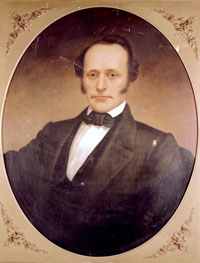Governor: 1859-1861
See also: John Willis Ellis, Dictionary of North Carolina Biography

John Willis Ellis (1820-1861) led North Carolina out of the Union and into the Confederacy. The son of Anderson and Judith Bailey Ellis, he was born on November 23, 1820, in eastern Rowan County (later Davidson County). He attended Randolph Macon College for one year before entering the University of North Carolina from which he graduated in 1841. Ellis then studied law under Judge Richmond M. Pearson and set up his practice in Salisbury in 1842. He was twice married, first to Mary White, who died only two months after their 1844 marriage. On August 11, 1858, six days after his election as governor, Ellis married Mary McKinley Daves, daughter of John Daves of New Bern. They had two daughters.
A Democrat, Ellis was elected a member of the House of Commons in 1844. In 1848, Dorothea L. Dix selected Ellis as liaison to champion her call for the establishment of a psychiatric hospital. Ellis was twenty-eight when the General Assembly elected him a judge of the Superior Court, an office he held until 1858 when he won his party’s nomination for governor. Ellis handily defeated his opponent, Duncan K. McRae.
As governor, Ellis pushed for faster movement of railroad freights, better plank roads and turnpikes, improvements in education, and completion of delayed river navigation projects. Hanging over his accomplishments, however, was the growing cloud of secession and sectional crisis. Running for reelection in 1860, Ellis denounced the abolitionists but steered clear of advocating dissolution of the Union. He used the constitutional question and southern rights to overshadow the issue of ad valorem taxation which was the trump card of his Whig opponent, John Pool. Even so, Ellis won by a much smaller majority than he had two years earlier.
On November 20, 1860, Ellis outlined a three-part strategy: participation in a conference of southern states to discuss the situation in the country, a state convention of the people to establish North Carolina’s position, and reorganization of the militia including creation of a corps of volunteers. In his inaugural address on January 1, 1861, he continued to urge moderation, but a group from the Wilmington area decided to seize Forts Caswell and Johnston despite the governor’s objection. He immediately ordered them to return control to the Union.
By early March deteriorating relationships had convinced Ellis that the state would soon have no choice but to join the Confederacy. When President Lincoln called for troops in April to put down the insurrection, the governor placed the state’s sympathies with the South. After answering the president “You shall get no troops from North Carolina,” Ellis ordered state troops to seize all federal forts and the Fayetteville arsenal, closing with a telegram to Confederate President Jefferson Davis, indicating that the state would support the Confederacy fully. All that was left was to make secession official at the May 20 convention.
Years of riding the circuit as a judge had weakened John Ellis’s health. Battling consumption, he tried to govern from a sick bed, relying upon a committee to help in decision making. He forced himself to make public appearances to maintain the morale of the people but finally gave in and, in a futile effort at recovery, journeyed to Red Sulphur Springs, Virginia. He died there on July 7, 1861, at age forty-one. Governor Ellis’s first burial took place in the family cemetery in Davidson County, but his remains later were removed to the Old English Cemetery in Salisbury.